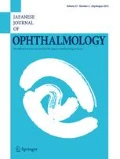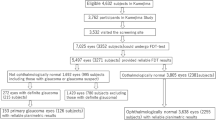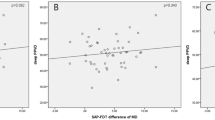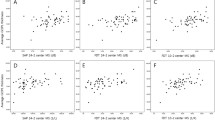Abstract
Purpose
to test the ability of frequency-doubling technology (FDT) perimetry to detect dysthyroid optic neuropathy (DON).
Methods
Fifteen eyes of 15 patients with DON and 15 healthy control eyes were studied. Eligible eyes had a diagnosis of DON based on visual field abnormalities on standard automated perimetry and had visual acuity better than 20/30. FDT testing was performed using both the C-20-5 screening test and the C-20 full-threshold test. Normal and DON eyes were compared with regard to FDT mean sensitivity.
Results
Sensitivity ranges were 40.0%–86.7% for the screening test, and 53.3%–100.0% (total deviation) and 20.0–93.3 (pattern deviation) for the C-20 threshold test. The corresponding specificity ranges were 86.7–100.0, 33.3–93.3, and 26.7–100.0, respectively. The best sensitivity/specificity ratios were for one abnormal point depressed <5% in the screening test (86.7%/86.7%), one point depressed <1% in the total deviation analysis (80.0%/86.7%), and one point depressed <2% in the pattern deviation analysis (80.0%/86.7%). DON eyes presented significantly lower than normal average sensitivity in the central, pericentral, and peripheral areas.
Conclusions
FDT perimetry is a useful screening tool for DON in eyes with normal or only slightly reduced visual acuity.
Similar content being viewed by others
References
Neigel JM, Rootman J, Belkin RI, et al. Dysthyroid optic neuropathy. The crowded orbital apex syndrome. Ophthalmology 1988;95:1515–1521.
Kazim M, Trokel S, Moore S. Treatment of acute Graves orbitopathy. Ophthalmology 1991;98:1443–1448.
Anderson D, Patella V. Automated perimetry, 2nd ed. St Louis: Mosby; 1999. p. 1–363.
Katz J, Tielsch JM, Quigley HA, Sommer A. Automated perimetry detects visual field loss before manual Goldmann perimetry. Ophthalmology 1995;102:21–26.
Khoury JM, Donahue SP, Lavin PJ, Tsai JC. Comparison of 24-2 and 30-2 perimetry in glaucomatous and nonglaucomatous optic neuropathies. J Neuroophthalmol 1999;19:100–108.
Wall M. What’s new in perimetry. J Neuroophthalmol 2004;24:46–55.
Bengtsson B, Heijl A, Olsson J. Evaluation of a new threshold visual field strategy, SITA, in normal subjects. Swedish Interactive Thresholding Algorithm. Acta Ophthalmol Scand 1998;76:165–169.
Johnson CA, Samuels SJ. Screening for glaucomatous visual field loss with frequency-doubling perimetry. Invest Ophthalmol Vis Sci 1997;38:413–425.
Quigley HA. Identification of glaucoma-related visual field abnormality with the screening protocol of frequency doubling technology. Am J Ophthalmol 1998;125:819–829.
Kelly DH. Nonlinear visual responses to flickering sinusoidal gratings. J Opt Soc Am 1981;71:1051–1055.
Fujimoto N, Adachi-Usami E. Frequency doubling perimetry in resolved optic neuritis. Invest Ophthalmol Vis Sci 2000;41:2558–2560.
Thomas D, Thomas R, Muliyil JP, George R. Role of frequency doubling perimetry in detecting neuro-ophthalmic visual field defects. Am J Ophthalmol 2001;131:734–741.
Wall M, Neahring RK, Woodward KR. Sensitivity and specificity of frequency doubling perimetry in neuro-ophthalmic disorders: a comparison with conventional automated perimetry. Invest Ophthalmol Vis Sci 2002;43:1277–1283.
Bartley GB, Gorman CA. Diagnostic criteria for Graves’ ophthalmopathy. Am J Ophthalmol 1995;119:792–795.
Tsukamoto H, Mukai S, Iwase A, Mishima HK. Recovery of reliability by retest after a 5-minute interval in frequency doubling technology perimetry. Jpn J Ophthalmol 2006;50:380–382.
Adams CW, Bullimore MA, Wall M, Fingeret M, Johnson CA. Normal aging effects for frequency doubling technology perimetry. Optom Vis Sci 1999;76:582–587.
Anderson AJ, Johnson CA. Frequency-doubling technology perimetry. Ophthalmol Clin North Am 2003;16:213–225.
Sample PA, Bosworth CF, Blumenthal EZ, Girkin C, Weinreb RN. Visual function-specific perimetry for indirect comparison of different ganglion cell populations in glaucoma. Invest Ophthalmol Vis Sci 2000;41:1783–1790.
Sackett DL, Haynes RB, Gyatt GH, Tugwell P. Clinical epidemiology. Houston: Little, Brown & Company; 1991. p. 1–441.
Kennerdell JS, Rosenbaum AE, El-Hoshy MH. Apical optic nerve compression of dysthyroid optic neuropathy on computed tomography. Arch Ophthalmol 1981;99:807–809.
Trobe JD, Glaser JS, Laflamme P. Dysthyroid optic neuropathy. Clinical profile and rationale for management. Arch Ophthalmol 1978;96:1199–1209.
Tsaloumas MD, Good PA, Burdon MA, Misson GP. Flash and pattern visual evoked potentials in the diagnosis and monitoring of dysthyroid optic neuropathy. Eye 1994;8:638–645.
Spadea L, Bianco G, Dragani T, Balestrazzi E. Early detection of P-VEP and PERG changes in ophthalmic Graves’ disease. Graefes Arch Clin Exp Ophthalmol 1997;235:501–505.
Acaroglu G, Simsek T, Ozalp S, Mutluay A. Subclinical optic neuropathy in Graves’ orbitopathy. Jpn J Ophthalmol 2003;47:459–462.
Salvi M, Spaggiari E, Neri F, et al. The study of visual evoked potentials in patients with thyroid-associated ophthalmopathy identifies asymptomatic optic nerve involvement. J Clin Endocrinol Metab 1997;82:1027–1030.
Ambrosio G, Ferrara G, Vitale R, De Marco R. Visual evoked potentials in patients with Graves’ ophthalmopathy complicated by ocular hypertension and suspect glaucoma or dysthyroid optic neuropathy. Doc Ophthalmol 2003;106:99–104.
Dayan CM, Dayan MR. Dysthyroid optic neuropathy: a clinical diagnosis or a definable entity? Br J Ophthalmol 2007;91:409–410.
McKeag D, Lane C, Lazarus JH, et al. Clinical features of dysthyroid optic neuropathy: a European Group on Graves’ Orbitopathy (EUGOGO) survey. Br J Ophthalmol 2007;91:455–458.
Fong KC, Byles DB, Constable PH. Does frequency doubling technology perimetry reliably detect neurological visual field defects? Eye 2003;17:330–333.
Gardiner SK, Anderson DR, Fingeret M, McSoley JJ, Johnson CA. Evaluation of decision rules for frequency-doubling technology screening tests. Optom Vis Sci 2006;83:432–437.
Heeg GP, Blanksma LJ, Hardus PL, Jansonius NM. The Groningen Longitudinal Glaucoma Study. I. Baseline sensitivity and specificity of the frequency doubling perimeter and the GDx nerve fibre analyser. Acta Ophthalmol Scand 2005;83:46–52.
Heeg GP, Stoutenbeek R, Jansonius NM. Strategies for improving the diagnostic specificity of the frequency doubling perimeter. Acta Ophthalmol Scand 2005;83:53–56.
Casson R, James B, Rubinstein A, Ali H. Clinical comparison of frequency doubling technology perimetry and Humphrey perimetry. Br J Ophthalmol 2001;85:360–362.
Fogagnolo P, Mazzolani F, Rossetti L, Orzalesi N. Detecting glaucoma with frequency-doubling technology perimetry: a comparison between N-30 and C-20 screening programs. J Glaucoma 2005;14:485–491.
Kalaboukhova L, Lindblom B. Frequency doubling technology and high-pass resolution perimetry in glaucoma and ocular hypertension. Acta Ophthalmol Scand 2003;81:247–252.
Author information
Authors and Affiliations
Corresponding author
About this article
Cite this article
Monteiro, M.L.R., Portes, A.L.F., Moura, F.C. et al. Using frequency-doubling perimetry to detect optic neuropathy in patients with Graves’ orbitopathy. Jpn J Ophthalmol 52, 475–482 (2008). https://doi.org/10.1007/s10384-008-0579-x
Received:
Accepted:
Published:
Issue Date:
DOI: https://doi.org/10.1007/s10384-008-0579-x




